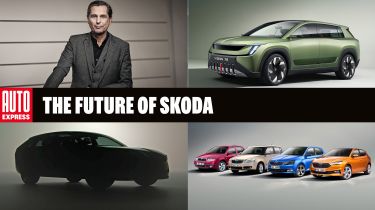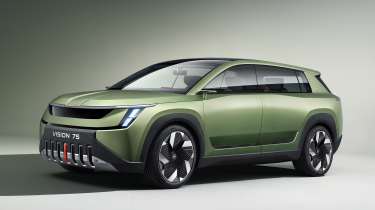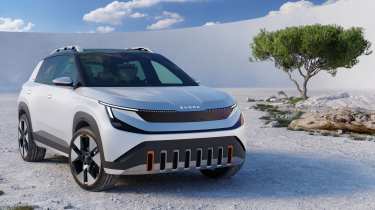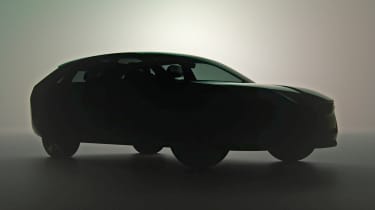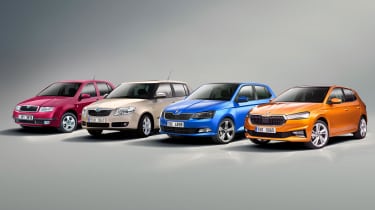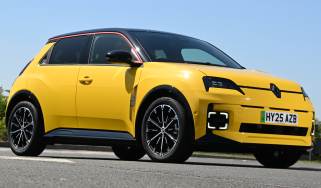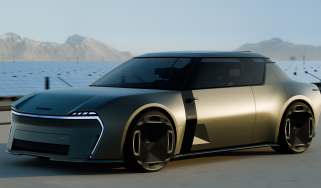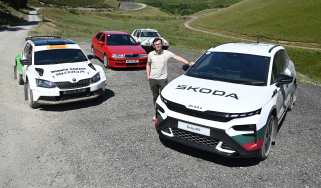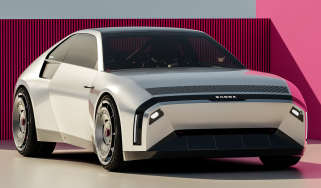The future of Skoda: CEO talks new cars and how it beat BMW
We’re not at peak Skoda yet – a flagship electric SUV and a small hatch will soon boost the line-up explains CEO Klaus Zellmer, in a long chat with Auto Express.
Skoda has overtaken BMW to become Europe’s third biggest-selling car brand, and it’ll keep its new product pedal to the metal with two new electric cars, facelifts for its entry models and a new Octavia concept.
The Czech brand’s European sales grew by 10 per cent in the first half of the year, with UK registrations up more than 16 per cent. Four-fifths of the company’s 509,400 units went to European customers, while its diversification strategy is delivering growth in India too.
How did Skoda clamber onto the European car sales podium for the first time? By offering a growing portfolio of models and powertrains that ticks every customer box, having competitive electric cars, delivering good quality at affordable prices and leveraging Skoda’s blooming brand power. That’s what company boss Klaus Zellmer told Auto Express during a fascinating, 90-minute conversation in London.
‘SpaceBEV’ one of two new Skodas coming in 2026
Zellmer, who recently had his CEO contract extended for another three years, believes that Skoda’s design is one factor in attracting customers. It achieves a delicate balance of looking sufficiently hi-tech with its Tech-Deck, illuminated grille while mixing reassuringly solid, crisp body surfaces that won’t scare anyone by looking too edgy.
“The tipping point in our design language is the introduction of Elroq, then the electric cars to come – the Epiq and flagship SUV next year. It’s a seven-seater with the working title ‘SpaceBEV’. That car totally embraces the new design language and our aspiration for a flagship Skoda, one that’s still very functional but also totally timeless.”
This electric alternative to the Kodiaq SUV – continuing Skoda’s tradition of having standalone EVs rather than electrifying existing nameplates – comes in the second-half of 2026. It’ll be longer than the Kodiaq to deliver huge cabin space, all underpinned by the Volkswagen group’s MEB electric car platform. That means a big battery around 90kWh in capacity, and single- and dual-motor punch.
“I'm proud that the car very much resembles the Vision 7S concept: we have not lost a lot on the way [to production, though] of course we don't have the suicide doors!”
Next year’s other new EV is going to be Epiq
An SUV at the opposite end of the size and price spectrum, the Epiq, will beat the seven-seater to market by arriving in spring 2026. The five-seater is the electric equivalent of Skoda’s 4.2m-long Kamiq. It’s set to get 38kWh and 56kWh batteries, with the latter promising up to 280 miles of range. And it introduces a new type of battery chemistry, to bring down the price to around £25,000.
“The Epiq will come with an LFP battery. It’s more cost efficient,” Zellmer confirmed. LFP – or lithium iron phosphate batteries – use cheaper raw materials than the Nickel Manganese Cobalt (NMC) batteries in existing Skoda EVs, which will also boost Skoda’s profits. The boss calculates 40 per cent of an EV’s cost is currently in the battery.
That’s a critical battleground, especially given Chinese rivals such as BYD – an early LFP adopter – have a cost advantage. “The more [customers] turn to battery electric vehicles, the more we have to tackle the cost of those cars in order to keep the profit levels we enjoy,” warns the CEO. “We’ve achieved price parity with the Elroq and the Karoq – but not cost parity.”
Having shifted 72,000 EVs between January and June 2025, Skoda is Europe’s second-biggest electric car brand, behind only its parent company Volkswagen. With many customers buying their first EVs, brand loyalties are still being established which makes the market a great leveller for Skoda.
Some 75 per cent of Enyaq buyers, Skoda’s first EV, are new to the brand. And the introduction of the new Elroq – Auto Express’s Car of the Year 2025 – has given Skoda extra momentum, with the model topping the EV sales chart in the UK and Europe at times this year.
Tempted by a Skoda Elroq? Check it out in Auto Express’s Buy A Car service, with savings of more than £2,000 on cars available to order now.
Enough about EVs! What’s Skoda’s plan for combustion cars?
Skoda offers a bewildering array of choice. This is neatly illustrated by the fact that while VW’s Passat is only available as an estate, its Skoda Superb sister comes as a hatchback too.
“It’s the widest portfolio we’ve ever had at Skoda, serving our mantra that we respect customers’ wish for choice: mild hybrid, plug-in hybrid, diesel car, SUV, sedan, hatch, kombi (estate), whatever you [want]. And we run on full steam in our factories, which is also good for profitability.”
The boss reveals the Fabia supermini, Kamiq SUV and midsize Scala hatchback – all resolutely combustion cars – have been inked into Skoda’s production plans beyond 2030. Skoda is Volkswagen group’s R&D centre for their MQB vehicle chassis and its combustion engines, which gives it responsibility for the engineering to get them through the upcoming Euro 7 emissions tests.
“With EU7 in 2027 they were planned for phase out because we would bring in the Epiq. The theory was everybody who wants an ‘A0’ [small car] will buy [that]. But it doesn't work like that!”
As a result the Fabia, Scala and Kamiq will receive cosmetic and spec upgrades before the end of the year. “You can’t just extend the lifecycle and think nobody will realise the age,” quips the boss. “They're making good money and [they’re] a vital part of our line-up.”
But electrified combustion is also important at higher price points. Plug-in hybrid is restricted to the Kodiaq and Superb yet it still accounted for 21,400 European registrations. Zellmer admits that’s too limited and promises to extend PHEV to the Octavia range too.
Where does the portfolio end: what is ‘peak Skoda’?
The SpaceBEV and Epiq may be the last new nameplates for a while. “I think we are at the peak of our portfolio,” agrees Zellmer.
After them the new Octavia will come as an electric car. It’ll be previewed by the aerodynamic Vision O concept in early September before arriving in 2027, which will begin the process of electrifying existing nameplates and ultimately a rationalisation of the range.
“Let’s see what happens with the Octavia as a battery electric vehicle. There's a certain efficiency cap – the most efficient one is probably Tesla having three cars in the market and selling the volumes it sells. This doesn't work for traditional car manufacturers. You cannot afford to run redundant cars with a massive overlap.”
Auto Express asked Zellmer to name his most important Skoda, and he listed the Octavia – the brand’s biggest selling model with 215,000 deliveries in 2024 – alongside two others. “From an image viewpoint the one that has probably carried the brand furthest is the Superb; in India [it’s seen] on the same level as a Mercedes. And from a profitability viewpoint, it’s the Kodiaq.”
The brand has certainly developed way beyond the ‘80s jokes that tittered the UK – its success now generates 5 per cent of the Czech Republic’s GDP. An independent study by Interbrand calculated that the brand’s value had jumped 40 per cent over the past five years. “It is on the shopping lists of people that five or 10 years ago would have never thought about buying a Skoda. But you can't stop: we need to develop the brand and the aspiration further,” urges Zellmer.
Not that the boss wants to head too far up market – he’s happy with the Superb being perceived as a rival to Mercedes saloons in India, rather than an actual rival. “We still want to be the best value-for-money car. Something that pleases your eyes, something that is contemporary, that is not fashionable but long-lasting and very functional.”
Zellmer, who worked for Porsche for 23 years before joining Skoda, has ticked one of his metrics for success by getting the European sales bronze medal. What else?
“A return on sales exceeding 8 per cent.” In the first half of 2025, Skoda delivered an 8.5 per cent margin, equating to €1.2-billion of operating profit. Cost cuts of €2.1-billion in the last two years have helped, as Skoda lets people retire and hires fewer people in new posts that reflect the changing, AI-driven industry. By 2030 Zellmer is targeting a 10 per cent operating margin.
Another goal is to get Skoda to exceed the 1-million sales mark; it delivered 926,567 cars in 2024. The previous high of 1.3-million included 300,000 Chinese sales, produced in a joint-venture which reduced the profits. Western car makers have lost enormous share in China since then.
Other markets such as the UK will fuel the latest growth push. “We’ve just exceeded 5 per cent market share in the UK, which makes us proud. But we’re number 12 in the market. If we gain another 0.8, 0.9 per cent market share, we can make it into the top five. So this is really what we need to do.
“But it’s not volume just for the sake of volume. We don’t celebrate market share if we lose money. But a reasonable next step has to be exceeding 1-million, simply because with scale you utilize your capacity better, and you generate incremental profit. This is the game plan,” he concludes.
Come and join our WhatsApp channel for the latest car news and reviews...
Find a car with the experts

